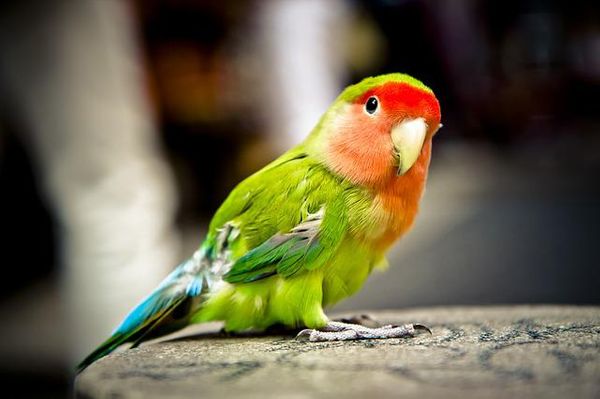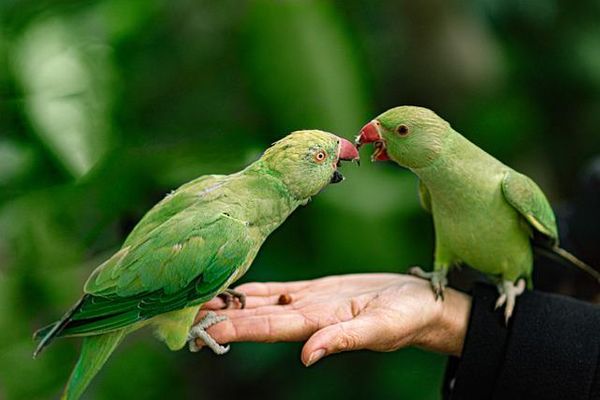Parrots are very intelligent creatures that have their own language. But there are times when they show signs of illness. As pet lovers, we should be more aware of some diseases that our parrots can get and how to protect them from getting them. Here we have listed some most common diseases in parrots. If your parrot is showing certain symptoms, consult a vet immediately.
Pox virus in Parrots
Poxviruses can infect many bird species, and each bird species may have its own unique species of pox virus (mynah bird pox, canary pox, parrot pox, etc.). Poxviruses can cause a variety of clinical syndromes depending on the part of the body infected.

Poxvirus Symptoms in Parrots
In birds infected with a poxvirus, there are several distinct clinical syndromes. Nodular or crusted areas of non-feathered skin are seen in the cutaneous (skin) form of the disease.
Poxvirus Treatment of Parrots
Prevention is the best form of control; keep your birds indoors and use insect-proof screening. Many birds will recover with supportive care; crust treatment may be necessary. If a secondary bacterial infection is present, antibacterial therapy is frequently used. Healthy birds can be immunized.
Adenoviruses, One of the Most Common Diseases in Parrots
Depression, anorexia, diarrhea, and cloacal hemorrhage have all been linked to adenovirus infections in psittacine birds. Adenovirus outbreaks have also been described as having a clinical progression similar to PsHV-1 infection, in which healthy birds are discovered dead in their enclosures.

Adenoviruses Symptoms of Parrots
This representation of avian adenovirus infection may result in death, dehydration, lethargy, clotting defects, and anemia.
EDS, for example, causes a decrease in egg production as well as soft, hypopigmented/pale, rough, misshapen, or thin shelled eggs.
Adenoviruses Treatment
Most adenovirus infections have no specific treatment, but HE has been successfully treated using convalescent antiserum from healthy flocks at slaughter as a vaccine.
Paramyxovirus
The nervous systems of small grass parakeets (Neophema species) will be affected by Paramyxovirus, resulting in head tilt and circling, as well as loss of balance.

Paramyxovirus Symptoms in Parrots
Clinical symptoms differ depending on which strain has infected which species. Birds can die suddenly or slowly from disease. Weight loss, sneezing, nasal discharge, labored breathing, yellow-green diarrhea, stumbling, and head bobbing are all common symptoms.
Wing and leg paralysis, jerky movements, and dilated pupils may be seen in severe cases. Lesions appear to have the greatest impact on the liver, spleen, and respiratory system.
Paramyxovirus Treatment in Parrots
There is no cure for PMV infection; only supportive care is available.
Papillomavirus in Parrots
Papillomas, also known as warts, are lesions or tumors that form on the skin of your bird and can take months to develop, persist for years, and then disappear on their own. They are commonly found on the feet and legs or the beak and head of finches, waterfowl, cranes, herons, and flamingos, as well as African grey parrots and canaries.
Papillomavirus Symptoms
Here are some symptoms to look out for:
- External lesions or warts noted on the skin of various parts of your bird’s body (most likely locations will be on legs, feet, head and beak)
- Internal cloacal papilloma prolapse
- Internal papillomas (those in the gastrointestinal system caused by several herpesviruses and found primarily in the Psittacine family) will not be detectable by simple observation.
Papillomavirus Treatment
Treatment is usually unnecessary unless the papilloma becomes inflamed and bleeds. When treatment is required, your veterinarian may recommend the following:
General excision of the papilloma via chemical cauterization or surgical removal is effective.
Your veterinarian will most likely advise you to isolate the afflicted bird as well as any other birds who may have been exposed.
To reduce the possibility of the virus spreading, thoroughly clean and disinfect the enclosure, food and water bowls, and non-porous toys.
Circovirus in Parrots
Psittacine Beak and Feather Disease (PBFD), also known as Avian Circovirus, is a viral disease that affects parrots and cockatoos. Various strains of avian circovirus can infect pigeons and passerines (such as canaries and finches). The virus has no effect on humans.

Circovirus Symptoms
Parrot beaks and claws are usually unaffected, but poor feathering can occur on any part of the body. Birds may be unable to fly due to stunted primary and secondary wing feathers.
Circovirus Treatment
Some birds may benefit from immune-boosting drugs, lifestyle changes, antiviral drugs that have a partial effect on circovirus, and other drugs to treat secondary infections.
Bornavirus
Avian bornavirus appears to be the causative agent of proventricular dilatation disease, a progressive and fatal neurological and gastrointestinal disease of birds first identified in the 1970s in macaws exported from Bolivia.

Bornavirus Symptoms
Because digestive efficiency is impaired, affected birds will eat well but lose weight, vomit frequently, and pass undigested food items (particularly seed kernels) in their droppings. Some birds will also exhibit nervous symptoms such as tremors or lack of coordination.
Bornavirus Treatment
There are no known treatments; however, your veterinarian may discuss the possibility of trying experimental treatments such as combining cytokines and antiviral drugs with you.
Aspergillosis
Aspergillosis is a fungal infection that causes respiratory problems in pets. It can cause upper respiratory problems (nose, sinuses, eye, and trachea) as well as lower respiratory problems (lungs and air sacs – a specialized part of the respiratory tract found in birds) or more widely distributed systemic infections.

Aspergillosis Symptoms
- Looking a little fluffed
- Depression and lethargy
- Loss of weight
- Exercise intolerance/respiratory difficulties
- Tail wagging
- Nose enlargement +/- discharge
- Inappetence
- Polydipsia is the medical term for excessive thirst.
- Polyuria is the term for excessive urination.
- If the voice box is affected, there may be vocalisation or a reluctance to speak. A click could be heard.
- Breathing with an open beak
Aspergillosis Treatment
This fungus is notoriously difficult to treat and cure. Antifungal medications, most commonly itraconazole (which Grey parrots do not tolerate well) or voriconazole (which appears to be more effective), are frequently used.
Treatment can be administered orally, inhaled, topically, or intravenously. Complete elimination can be extremely difficult if a bird’s immune system is compromised.
Tapeworms in Parrots
Gastrointestinal parasites not only cause problems in the stomach and intestines of birds, but they also interfere with the normal functions of other organs. Tapeworms are a type of parasite that affects the digestive tract of birds.
Tapeworms are commonly found in cockatoos, African Grey parrots, and finches.

Tapeworms Symptoms
Tapeworms found in an infected bird’s stomach and intestines cause no obvious symptoms.
Tapeworm Treatment
The veterinarian will perform tests on the infected bird’s droppings and then prescribe tapeworm-killing medication. Depending on the severity of the infection, the medicine can be administered orally or intravenously to the infected bird. However, more than one dose is required to completely eliminate this gastrointestinal parasite. ( source)
These are some of the most common diseases in parrots. For other pets, explore pet care.
Also read: Health Views: Most Common Diseases in Goats – Symptoms & Treatment





